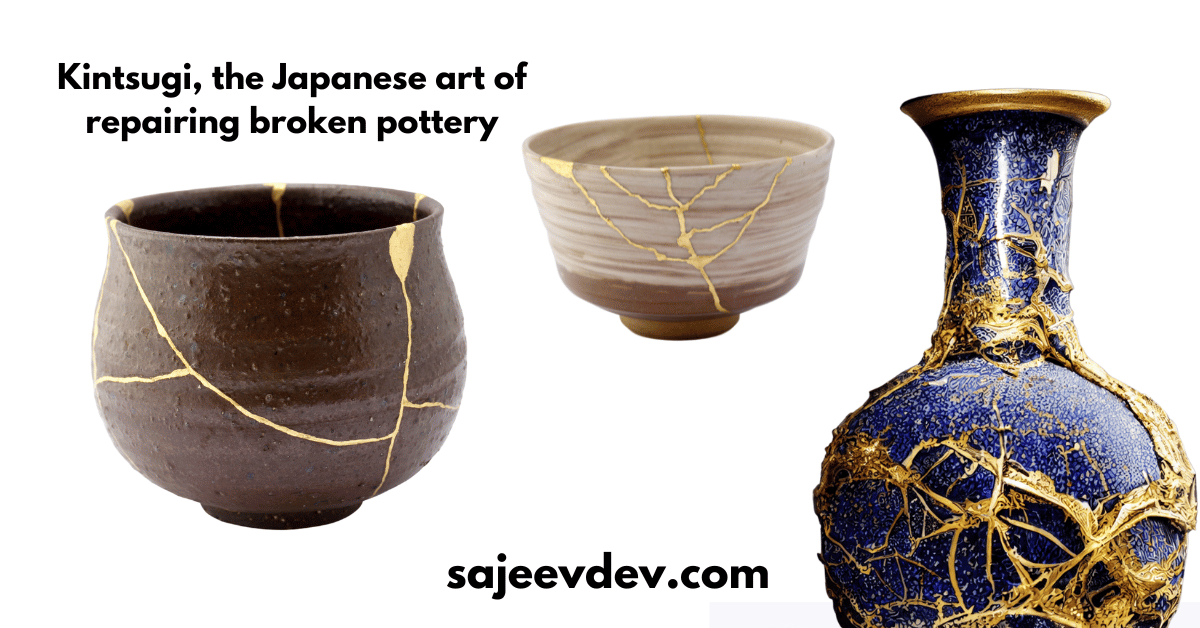Kintsugi is a profound and lyrical practise that plays a significant role in the sphere of Japanese arts. Kintsugi is the art of restoring shattered pottery with gold. In addition to being a celebration of tenacity, an ode to imperfection, and a testament to the transforming beauty that emerges from tragedy, it goes beyond the concept of simple restoration. There is a universal truth that is whispered by the very essence of Kintsugi, which is that the faults of life, such as broken crockery, can be transformed into works of art.
The Artistry of Kintsugi
“Kintsugi,” when translated, reveals its lyrical value, which might be interpreted as “golden joinery.” Through the use of precious gold, this age-old art form includes repairing broken pieces of pottery, so transforming the item that was previously damaged into something that is even more magnificent than it was before. It is a visual symphony of resilience, in which the cracks and fractures are not concealed but rather amplified, with each one expressing a story of survival and development.
A Tale of Broken Beauty
Kintsugi can be traced back to the 15th century, when the Japanese shogun Ashikaga Yoshimasa was confronted with the emotional distress of a Chinese tea bowl that had been broken. Yoshimasa was dissatisfied with the straightforward repair technique that involved metal staples, so he looked for a solution that was more sophisticated. The notion of Kintsugi was first developed by a craftsman from the area, who filled the fissures with lacquer that was then infused with golden powder. The end product was not merely a bowl that had been fixed; rather, it was a masterpiece that perfectly exemplified the art of accepting imperfections.
Philosophy in Golden Veins
When it comes to restoring broken pottery, kintsugi is more than just a technique; it is a philosophy that is firmly ingrained in Japanese society. It fits in with the wabi-sabi philosophy, which is a respect for the transience of things. This perspective on the world acknowledges that everything is imperfect and ephemeral in equal measure. The Japanese nobility discovered a symbol of beauty that emerged from brokenness in the golden veins of an object that had been restored using the Kintsugi technique. This served to reinforce the fundamental belief that defects tell stories of strength and survival.
Resilience as Art
The figurative significance of kintsugi extends beyond the realm of pottery restoration; it becomes a symbol of perseverance during this process. In life, just like the shards that have been broken, there are obstacles and failures. However, just as the bowl that has been restored using Kintsugi emerges stronger, so too can individuals discover renewed strength and knowledge for themselves when confronted with misfortune. The cracks become not signs of weakness but rather evidence of one’s capacity to persevere and transcend.
Embracing Scars as Golden Tales
The practise of Kintsugi teaches us that our shortcomings and defects are not blemishes that should be concealed but rather narratives that should be embraced. These golden veins that thread through the cracks contribute to the beauty of the pottery, just as our scars and defects are what make us who we are and what sets us apart from others. The trip that we take through life becomes a canvas, and each event adds to the intricate artwork that is our existence.
Transformative Beauty in Brokenness
A change of viewpoint is necessary in order to transform the flaws that are inherent in life into works of art. Consider the difficulties you face to be opportunities for personal development and transition rather than impediments to your progress. In the same way that the artisan of Kintsugi purposefully emphasises the cracks, we, too, have the ability to purposefully seek beauty in our wounds, discovering strength and resilience in the same places where we were previously broken.
Embodying Kintsugi Living
To live a life that is inspired by Kintsugi means to accept faults as a natural and inevitable aspect of the human experience. A recognition that the road through life is a mosaic of highs and lows, wins and disappointments is what this phrase refers to. In the same way that a good artisan can repair pottery with golden seams, we have the ability to transform our difficulties into golden stories, so transforming our lives into works of art that inspire and uplift others.
In the spirit of Kintsugi, let us appreciate the beauty that may be found in the shattered moments that have occurred throughout our lives. Our defects are transformed into masterpieces that shine with the brightness of a life well-lived as we become living embodiments of Kintsugi. As we mend our broken pieces with the gold of resilience and self-love, we become living embodiments of Kintsugi.



